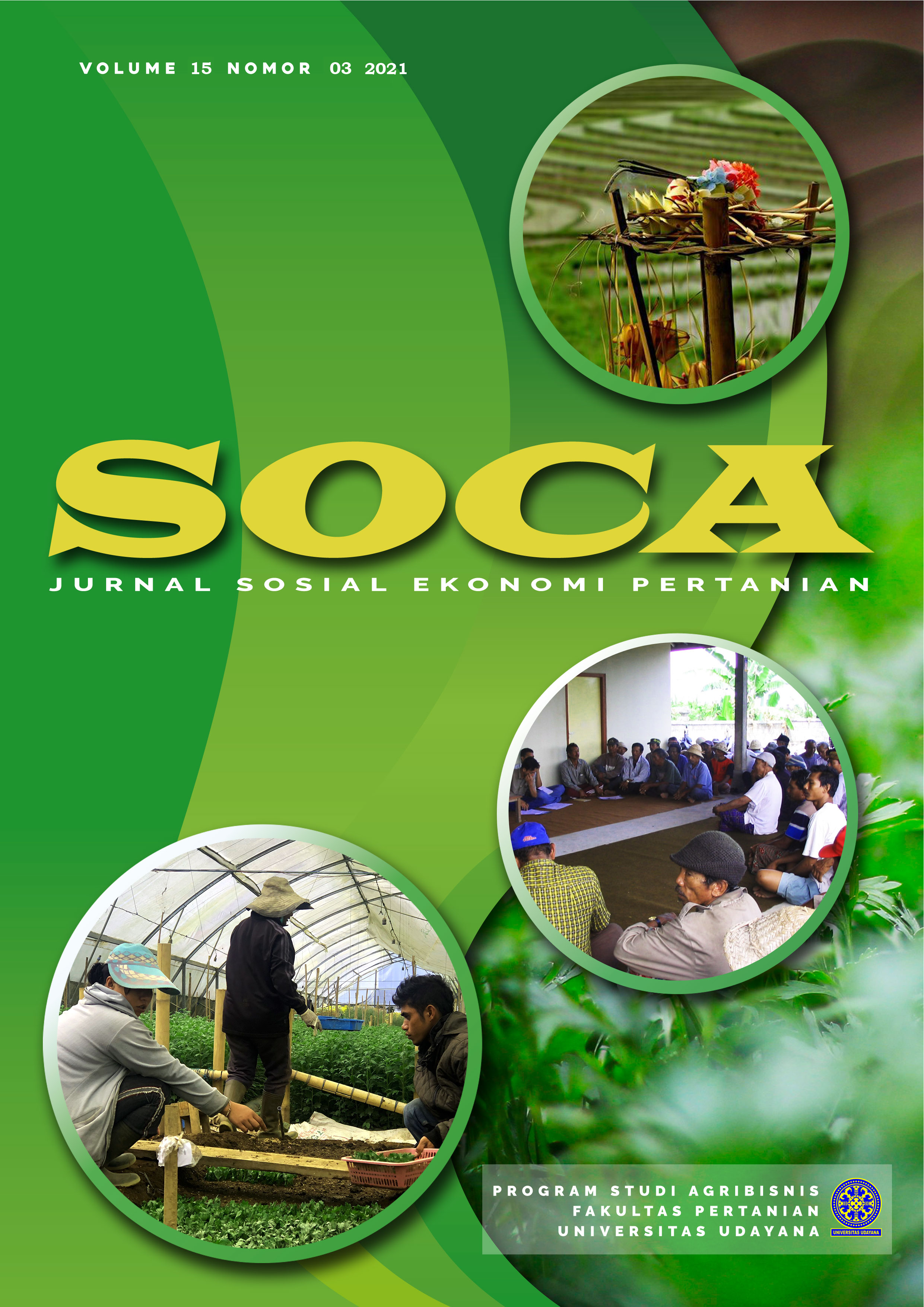The Livelihood Strategy of Rubber Tapper Households
Abstract
Livelihood strategy is a method or tactic that used by a person or group to survive by using assets condition that they have, such as human capital, physical, nature resource, financial, and social capital. The aims of the research were to analyze the impacts of temporary suspension of one of rubber operational factory to the rubber tapper households, to find out the conditions of rubber tapper household assets, and to analyze the livelihood strategy that being used by the rubber tapper households in order to fulfill their family living. This research conducted in March 2020 at PT Perkebunan Nusantara IX Kebun Batujamus, Kuto Village, Kerjo Sub-district, Karanganyar Regency. The data of the research collected by using methods such as observation, documentation, indepth interview, and literature study. The informants of the research consisted of 12 key informants and 3 supporting key informants. The data of the research was analyzed using descriptive qualitative method and analysis method of Miles and Huberman interactive data model. The research also used source and methodological triangulation. The research results showed that the temporary suspension of one of the company’s factories had an impact to the rubber tapper promotion. Rubber tapper households used multiple livelihood strategy, which was combining the on-farm income and off-farm income.
Downloads
References
Bhandari, B. S., & Grant, M. (2007). Analysis of livelihood security: A case study in the Kali-Khola watershed of Nepal. Journal of Environmental Management. https://doi.org/10.1016/j.jenvman.2006.07.010
Brown, D., Stephens, E., Ouma, J., Murithi, F., & Barrett, C. B. (2006). Livelihood strategies in the rural Kenyan highlands. African Journal of Agricultural and Resource Economics.
Ellis, F. (2000). The determinants of rural livelihood diversification in developing countries. Journal of Agricultural Economics. https://doi.org/10.1111/j.1477-9552.2000.tb01229.x
Fridayanti, N., & Dharmawan, A. H. (2015). ANALISIS STRUKTUR DAN STRATEGI NAFKAH RUMAHTANGGA PETANI SEKITAR KAWASAN HUTAN KONSERVASI DI DESA CIPEUTEUY, KABUPATEN SUKABUMI. Sodality: Jurnal Sosiologi Pedesaan, 1(1). https://doi.org/10.22500/sodality.v1i1.9388
Groenewald, S. F., & Bulte, E. (2013). Trust and livelihood adaptation: Evidence from rural Mexico. Agriculture and Human Values. https://doi.org/10.1007/s10460-012-9383-9
Guest, G., Bunce, A., & Johnson, L. (2006). How Many Interviews Are Enough?: An Experiment with Data Saturation and Variability. Field Methods. https://doi.org/10.1177/1525822X05279903
Jiao, X., Pouliot, M., & Walelign, S. Z. (2017). Livelihood Strategies and Dynamics in Rural Cambodia. World Development. https://doi.org/10.1016/j.worlddev.2017.04.019
Khatiwada, S. P., Deng, W., Paudel, B., Khatiwada, J. R., Zhang, J., & Su, Y. (2017). Household livelihood strategies and implication for poverty reduction in rural areas of central Nepal. Sustainability (Switzerland). https://doi.org/10.3390/su9040612
Lawless, S., Cohen, P., McDougall, C., Orirana, G., Siota, F., & Doyle, K. (2019). Gender norms and relations: implications for agency in coastal livelihoods. Maritime Studies. https://doi.org/10.1007/s40152-019-00147-0
Li, R., Zheng, H., Zhang, C., Keeler, B., Samberg, L. H., Li, C., Polasky, S., Ni, Y., & Ouyang, Z. (2020). Rural household livelihood and tree plantation dependence in the central mountainous region of Hainan island, China: Implications for poverty alleviation. Forests. https://doi.org/10.3390/f11020248
Mahama, T. A.-K., & Maharjan, K. L. (2017). Determinants of livelihood diversification in Ghana from the national livelihood strategies and spatial perspective. Journal of International Development and Cooperation, 23(1・2), 75–90. https://doi.org/10.15027/42500
Martin, S. M., & Lorenzen, K. (2016). Livelihood Diversification in Rural Laos. World Development. https://doi.org/10.1016/j.worlddev.2016.01.018
Miles, M. A. (1994). Miles and Huberman (1994)- Chapter 4.pdf. In Qualitative Data Analysis: An Expanded Sourcebook.
NURMANAF, A. (2004). Peranan Sektor Non Pertanian Terhadap Pendapatan Rumah Tangga Petani Berlahan Sempit. SOCA: Socioeconomics of Agriculture and Agribusiness, 4(3), 1–12.
Peng, W., Zheng, H., Robinson, B. E., Li, C., & Wang, F. (2017). Household livelihood strategy choices, impact factors, and environmental consequences in Miyun Reservoir Watershed, China. Sustainability (Switzerland). https://doi.org/10.3390/su9020175
Ruiz Pérez, M., Belcher, B., Fu, M., & Yang, X. (2004). Looking through the bamboo curtain: An analysis of the changing role of forest and farm income in rural livelihoods in China. International Forestry Review. https://doi.org/10.1505/ifor.6.3.306.59968
Sarmanu. (2017). Dasar Metodologi Penelitian Kuantitatif Kualitatif dan Statistika. In Airlangga University Press.
Scoones, I. (1998). Sustainable rural livelihoods: a framework for analysis. IDS Working Paper.
Strauss, A., & Corbin, J. (2003). Dasar-dasar penelitian kualitatif : tatalangkah dan teknik-teknik teoritisasi data. In Pengolahan Air Limbah Domestik Individual Atau Semi Komunal.
Sugiyono. (2015). Metode Penelitian. Metode Penelitian.
Widiyanti, E., Karsidi, R., Wijaya, M., & Utari, P. (2019). Farming occupation in the views of farmer families in rural area. IOP Conference Series: Materials Science and Engineering. https://doi.org/10.1088/1757-899X/633/1/012060
Widodo, S. (2009). STRATEGI NAFKAH RUMAH TANGGA NELAYAN DALAM MENGHADAPI KEMISKINAN Slamet Widodo. Jurnal KELAUTAN.
Xu, D., Zhang, J., Rasul, G., Liu, S., Xie, F., Cao, M., & Liu, E. (2015). Household livelihood strategies and dependence on agriculture in the mountainous settlements in the three gorges reservoir area, China. Sustainability (Switzerland). https://doi.org/10.3390/su7054850













